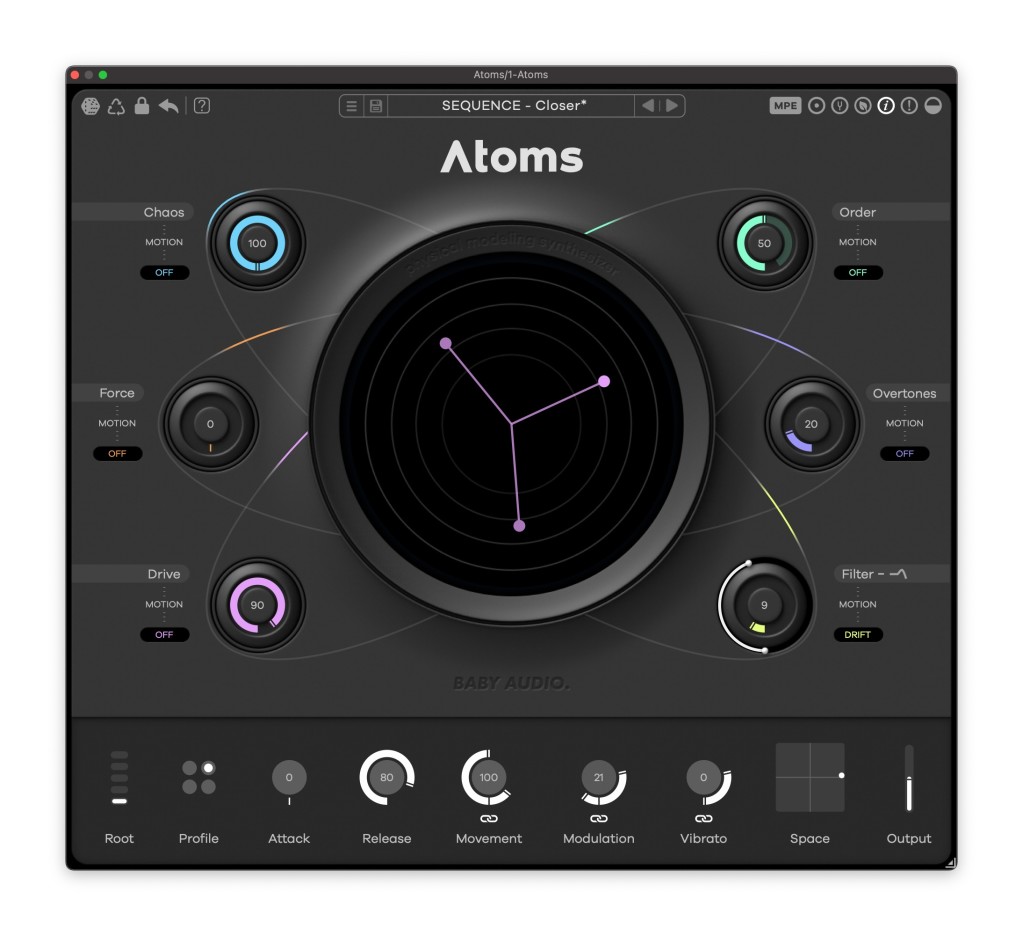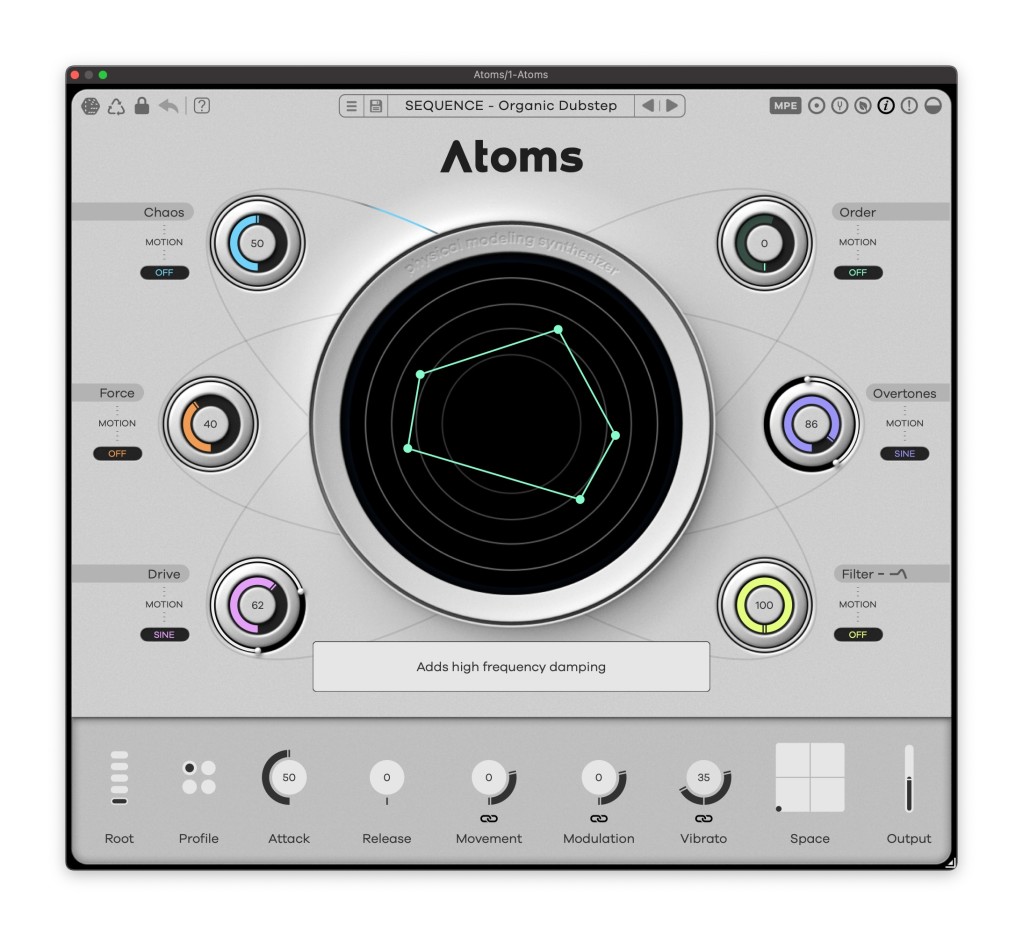Atoms is a gem of a new physical modeling soft synth, built on a structure of masses and springs, with intuitive and expressive control of bowed, organic, and alien sounds alike. Here’s a hands-on with Baby Audio’s latest plug-in.

Back to the future
Baby Audio has been most known for their effect plug-ins. I loved their first entry into software instruments, the BA-1, (read my review). But it was absolutely a retro affair, modeled on the Yamaha CS01 and focusing on some warbly lo-fi effects, down to modeling the internal speaker and what happens when the batteries die. And, to be honest, as I look back at which Baby Audio plug-in I return to again and again, that’s overwhelmingly been Spaced Out – their effect least like vintage gear. (Spaced Out is loosely Space Echo-ish, but it’s more a digital, modern, modulation-based take rather than another gauzy recreation of retro tape equipment.)
So to everyone who said, “why can’t we have something forward-looking, something more unusual, something that isn’t a model of old gear?” – oh, you’ve got it. Atoms is all about expressive, otherworldly sounds. It ventures into physical modeling territory with a unique sonic character and interface design all its own.
To everyone who said, “why can’t we have something forward-looking, something more unusual, something that isn’t a model of old gear?” – oh, you’ve got it.
Atoms is a bowed instrument with a structure of masses and springs underneath, with loads of automation for making sounds shift over time. That makes it closest in spirit to Apple’s Sculpture – which, even around two decades later, remains an edge case even among other physical modeling instruments.
Physical Modeling school
For a complete, engaging nerd-out on how this works, lead developer Silvin Willemsen was through the process. It’s like Christopher Nolan, for synthesis heads.
Like a lot of the best software, finding new sounds meant rooting the instrument in some actual research. Silvin has a doctoral-level background in instruments, and it’s doubly worth watching as you’ll get a sense of how the parameters actually work. The clever animations you see in the UI really are visualizing what’s going on behind the scenes, so they’re not only eye candy.
Spring is in the air
We haven’t seen that many successful physical modeling instruments, full stop, let alone ones that focus this much on the mass-spring network. That approach yields some unique sounds, in that you can easily shift from acoustic-like, organic creations to “more than physics” examples that sound both natural and artificial at once – like you’d expect an instrument to behave on another planet, maybe, made out of a material we don’t have on Earth.
It’s all fully explored both in a factory library and an extra “Radioactive” expansion by Zardonic. And it’s uncommonly possible to take each preset in a different direction with even subtle tweaks.
You can also use all the automation to create morphing, shifting sounds. But just as crucially, everything is MIDI mappable – and there’s complete (assignable) support for MPE. I found this expressive and playable even with a basic Arturia keyboard, but then plugging in an Osmose and this becomes truly next-level. You can invent an instrument (or tweak one of the excellent presets), and immediately play something that feels like an instrument – even a Romulan instrument.
One reason it’s worth having multiple physical modeling instruments is, these kinds of system interactions take on such different behaviors. Thanks to nonlinearities, each physical modeling instrument can be truly unique. Atoms has a special personality – perfect alongside other physical modeling greats.
Thanks to nonlinearities, each physical modeling instrument can be truly unique. Atoms has a special personality – perfect alongside other physical modeling greats.
Order and chaos
Here’s a basic rundown of the parameters:
Chaos adds nonlinear behavior in the mass-spring system – this is where you get all these unique pitch bends, even without applying custom control.
Order damps higher frequencies, which is useful for making more realistic sounds (as this rolling off of high frequencies occurs naturally) as well as taming some of the unruly resonances any physical model can introduce. Of course, you can also dial it down for glassy, shrill, more synthetic sounds.
Force is the usual “how much bow pressure” parameter.
Overtones controls the position along the network – Sculpture users will recall that horizontal visualization of the same idea – as if you’re playing closer to a bridge.
Drive gives you a waveshaping function for emphasizing harmonics.
Filter is a low-pass filter with resonance (sounds ladder-style).
This is all pretty straightforward and familiar, but what I’m struck by is how much musical range you get across each parameter. Physical modeling synths tend to gravitate (sorry) to one of two extremes. Either they keep everything safe enough that you don’t wreck your speakers or make something unpleasant but in the process limit your sound choices, or they give you a bunch of options and … there go your ears. The parameters here are musical enough that you can even control them live, which is truly rare.
That puts Atoms quickly in a very short list of truly useful physical modeling synths, particularly the Applied Acoustics Systems range and Reason Studios’ Objekt and Friktion. (I love Sculpture, but I think the others here give you good reason not to contend with that instrument’s eyestrain-inducing UI and sometimes glitchy sound engine!) Make no mistake: for all the reality-warping possibilities here, there’s a deep, organic playability to what you create.

It’s then fantastically easy to quickly assign modulation and automation. Kudos to Baby Audio for simplifying here – you just dial up the motion you want on a parameter. Pick a shape, amount, change LFO mode (free/retrigger/hold), automation direction, and host sync on/off. You can even copy/paste between parameters. (Basically, hover over every little bit of that menu above!)
Make no mistake: for all the reality-warping possibilities here, there’s a deep, organic playability to what you create.

Along the bottom, you get a similarly ingenious control setup. Just set attack and release, plus movement (the “bowing”), modulation, and vibrato – with sync/free switches for each. Sure, there are synths with more elaborate modulation matrices and controls, but this gives you 80% of that capability while fitting everything neatly under your fingertips.
You also get a simple, analog-style root octave control, plus space size/mix, which recalls the nice algorithms of Baby Audio’s effects.
There are also four profiles, each of which sounds unique:
- Standard
- Inharmonic
- Alternative
- Lo-fi
Those aren’t really detailed in the manual, but just try them. Lo-fi gets grungy and works really well for bass. The other modes produce really different results depending on parameters. Or check my demo video, as you’ll see me swapping them. (They do stop notes, so you get a short drop-out – it’s the one parameter you probably shouldn’t use live, though I did it anyway.)
And this being Baby Audio, there’s tons of randomization. There’s the maker’s signature “Magic Dice,” though you can easily exclude any parameter with the lock button. And you get variations with Recycle. (Reason Studios also took this approach and given the number of happy accidents you get from physical modeling synths, I’m there for it – especially with the ability to restrict what gets varied. Looking further back, Kai Krause did this with a lot of his graphic tools in the 1990s.)
Here’s a good play with it, complete with some natural pitch bending with the model itself.
It’s all an instant favorite for me. Honestly, for anyone tired of subtractive synthesis, physical modeling can give you a whole lifetime of stuff to explore. But I’m completely biased; I enjoy physical modeling synthesis like some people enjoy sunshine or food.
Have at it – VST/AU/AAX, macOS/Windows, 41% off intro sale:
Atoms is on sale now at Plugin Boutique, and available in a number of bundles with their other great stuff. (Seriously, Spaced Out and Crystalline, at the very least…)
If you buy something from a CDM link, we may earn a commission.
Baby Audio Atoms [Plugin Boutique]
Baby Audio developer page at Plugin Boutique
I hope we get an iOS version, like with BA-1, as this would be a beautiful synth to have as a mobile app for live use (and playing in everyone’s favorite venue, your bed).